Good Night everyone for all of our friends who are at Blurtter and have been joining Blurtter for a long time, hopefully we are always healthy and can always carry out activities as usual. So on this occasion I want to write a little bit about Pellenes | Photography | Macro hopefully later it can become a memory for myself, and for other friends who are already married, don't forget to also give directions and input if later in my writing there are still words- words that are not polite, therefore I apologize once again.

so on this very occasion I will write a little about one of the types of spiders that we can see, namely the climbing spider, or one of the spiders that is very easy for us to find, so it is easy for us to recognize it. The natural name of this spider is Salticidae or jumping spiders is a family of spiders consisting of more than 5,000 species in 530 genera or about 13% of all spider species which makes Salticidae the largest spider family. Several species of Salticidae have the best eyesight of any arthropod and use them in mating, hunting and navigation. Although they usually move quietly and fairly slowly, most species are capable of very agile jumps, especially when hunting, or occasionally in response to sudden threats. Their book pulmonary and tracheal systems are well developed and they use both systems (bimodal respiration). Jumping spiders are usually recognized by the arrangement of their eyes. All jumping spiders have four pairs of eyes with one pair specifically being their large anterior median eye.

Jumping spiders are among the most easily distinguished from other spider families because of the shape of their cephalothorax and the arrangement of their eyes. The families closest to Salticidae in general physical appearance are Corinnidae (distinguished by prominent spines on the back of the four legs), Oxyopidae (distinguished by very prominent spines on all legs), and Thomisidae (crab spiders, which are distinguished by their four very long and strong front legs). However, none of the three families have eyes resembling those of the Salticidae. In contrast, the legs of a jumping spider do not have any protruding spines. Their front four legs are generally larger than their back four, but not as dramatic as those of crab spiders, nor are they able to stand in the outstretched position of the forelegs characteristic of Thomisidae. Despite their long forelimbs, Salticidae rely on their hind limbs for hopping. Generally the forelimbs are used to assist in catching prey and in some species, the forelimbs and pedipalps are used as species identification markers.
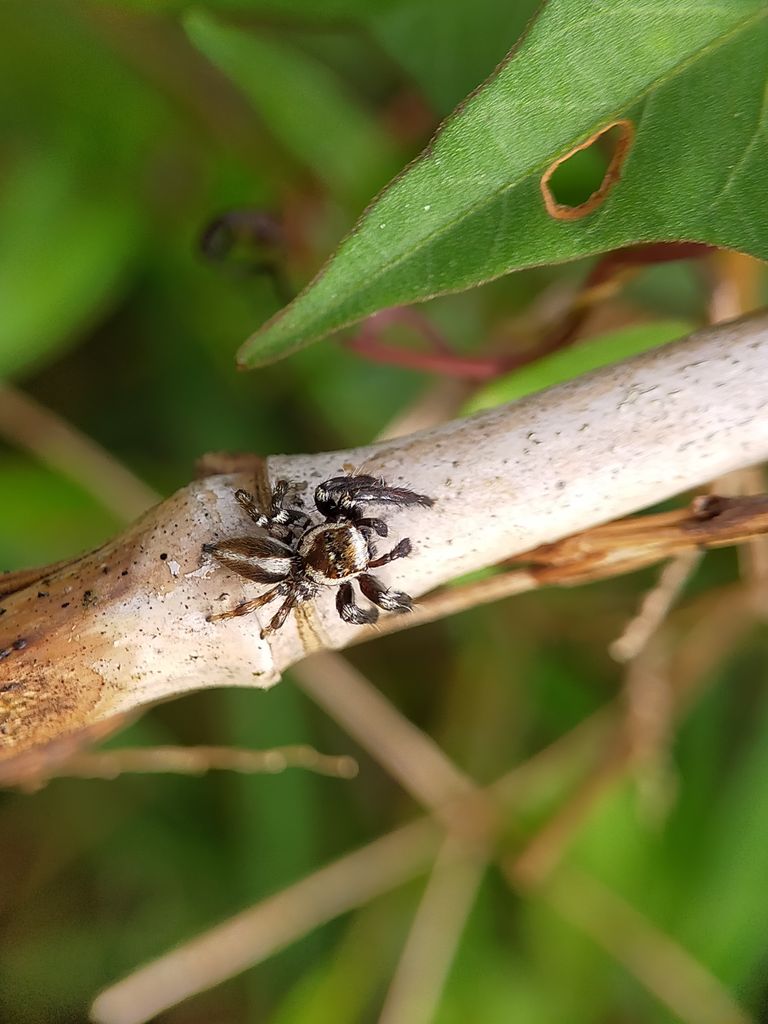
Jumping spiders, unlike other families, have faces that are roughly rectangular in shape and appear perpendicular to the direction of their movement. In effect, this means that when viewed from the front, their anterior eyes are on a "flat face", as shown in the photo. Their eye pattern is the most obvious single identifying characteristic. They have eight eyes, as illustrated.[4][5] The most common markings are the four eyes in the front row, in which the anterior median pair of eyes protrude dramatically more than any other spider's eyes, except for the posterior median eyes of Deinopidae. Nonetheless, there is a radical functional difference between the main eyes of the Salticidae and the main eyes of the Deinopidae; the large posterior eye of Deinopidae is adapted primarily for vision in dim light, while the large anterior eye of the Salticidae becomes an extremely clear three-dimensional vision device for the purpose of predicting the range, direction, and character of potential prey, thus enabling the spider to direct its attack jumps with extreme precision. . The anterior lateral eyes, although large, are smaller than the anterior median eyes and provide a wider forward field of vision.
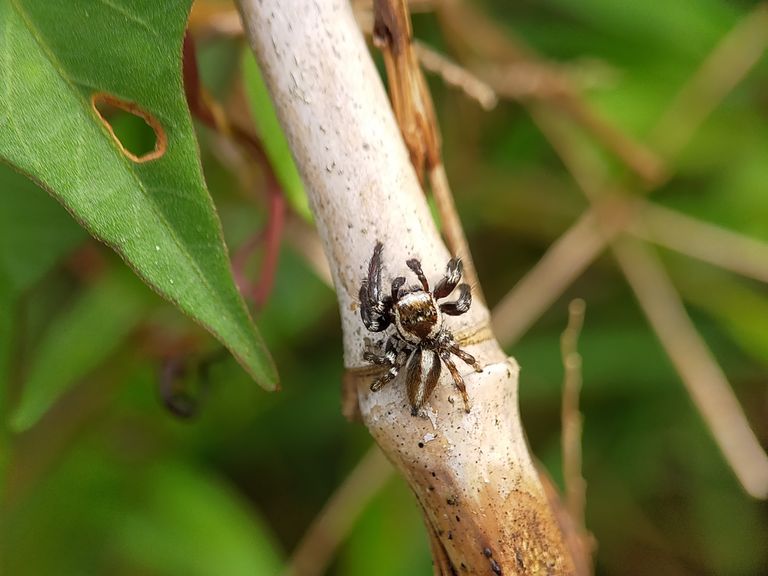
The jumping spider family is very easy to distinguish from other spider families because of the shape of the cephalothorax and the arrangement of their eyes. The families closest to Salticidae in terms of morphological features are Corinnidae (distinguished by protruding spines on the back of the four legs), Oxyopidae (distinguished by very prominent spines on all the legs), and Thomisidae (distinguished by their very long and pointed front four legs). strong). However, none of the three families have eyes resembling those of the Salticidae. In contrast, the legs of a jumping spider do not have any protruding spines. The four forelegs of Salticidae are generally larger than the four hind legs. Despite their long forelimbs, Salticidae rely on their hind limbs for hopping. Generally, the front legs are used to catch prey. The body length of jumping spiders varies greatly from 1 to 22 mm (0.04-0.98 inches). The largest species is Hyllus giganteus from Indonesia and Australia. Venomous Spiders. Salticidae have a "can" like a snake. Although the jumping spider has venom to sedate its prey, it is not strong enough to harm humans. Useful as a predator and pest control. Interactions between predators and prey are very common in the wild. Now this is beneficial for the balance of the ecosystem. If spiders go extinct, there will probably be lots of ants, termites, mosquitoes and other small insects in your house.
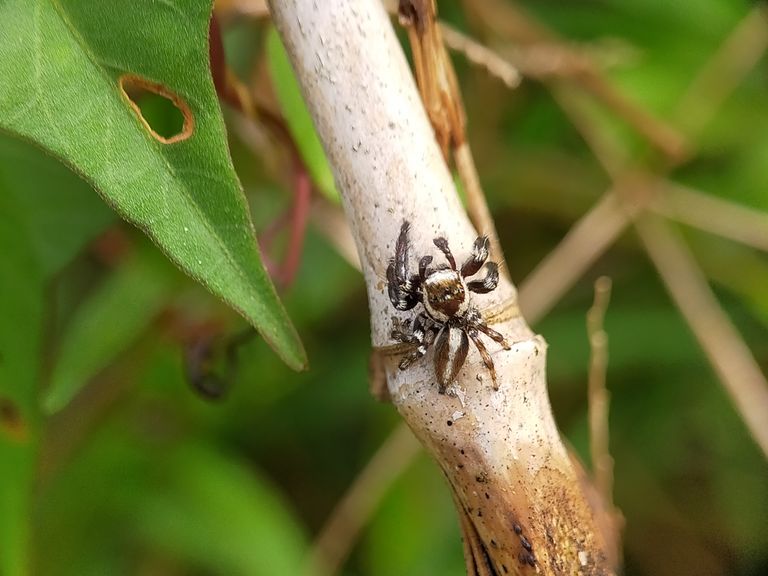
The four eyes in the rear row may be described as highly aberrant, or rearranged in two rows, with the two large lateral posterior eyes very far back. The four eyes are used for lateral vision. The body length of the jumping spider varies from 1 to 22 mm (0.04-0.98 inches). The largest species is Hyllus giganteus and other genera with relatively large species are Phidippus, Philaeus, and Plexippus. They use their silk for protection when jumping and to make cages, where they take shelter from bad weather and sleep at night. It is also in this place that they molt, store their eggs, and spend the winter. Jumping spiders have four pairs of eyes. The primary pair of eyes are movable and the three pairs of secondary eyes are immovable. In many species the posterior median eyes (English: posterior median eyes or PME for short) are vestigial, but in some primitive subfamilies they are about the same size as the other secondary eyes and aid in motion detection.[10] Because they cannot form images, it is suspected that the reduced function of the eye pair has the same affectionate role as the insect ocelli, namely to receive light. The photoreceptors in the secondary pair of eyes are almost exclusively sensitive to green light, but the PME has two visual pigments that differ from all other eyes which are sensitive to blue and ultraviolet light.

If we ask what animals we can find everywhere on this earth, maybe the answer that comes closest to that is spiders. There are about 6080 species in 635 genera. And 13% of them are species of Salticidae or jumping spiders. Indeed, if we don't pay close attention, they will disappear in the leaves or shrubs. That's because of their small size and hiding skills. A jumping spider can quickly crawl under a leaf if there is something they perceive as a threat. Several species of Salticidae, or jumping spiders, have the best eyesight of any arthropod, and use it in mating, hunting, and navigation. Although they usually move quietly and fairly slowly, most species are capable of jumping very agilely, especially when hunting, or occasionally in response to a sudden threat. Jumping spiders are usually identified by the arrangement of their eyes. All jumping spiders have four pairs of eyes with one pair specifically being their large anterior median eye. The large anterior eyes of the Salticidae provide a very clear three-dimensional vision device with the aim of predicting the range, direction and character of potential prey, thus enabling the spider to direct its attack jumps with great precision. The anterior lateral eyes, although large, are smaller than the anterior median eyes and provide a wider forward field of vision. The four eyes in the rear row may be described as highly aberrant, or rearranged in two rows, with the two large lateral posterior eyes very far back. The four eyes are used for lateral vision.
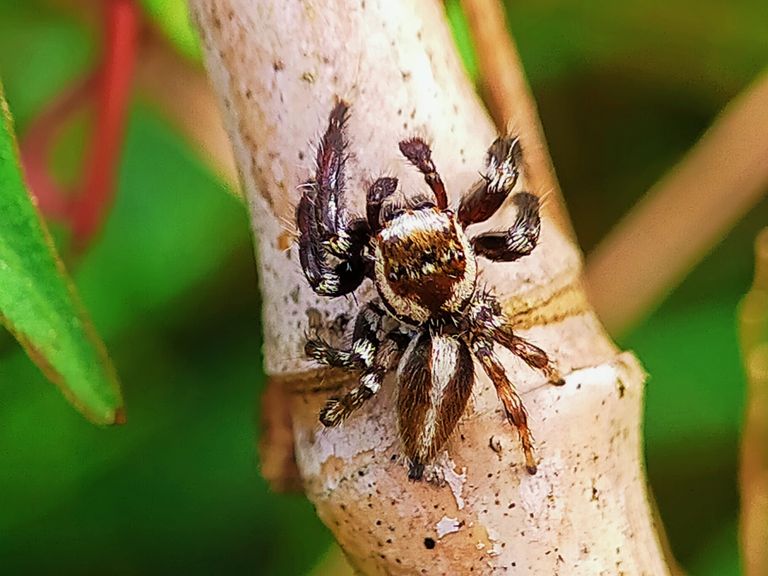
The hunting behavior of jumping spiders is very diverse compared to most spiders in other families. These spiders hunt the reverse of the rule, which is consistent with their highly developed visual system. When detecting potential prey, the jumping spider usually begins to orient itself by rotating the cephalothorax to bring the anterior median eye to a fulcrum. It then moves its abdomen in line with the cephalothorax. After that, it may spend some time examining the object of its attention and determining whether disguised or doubtful prey is promising, before beginning to walk slowly forward. When it gets close enough, the spider stops to set up the dragline, then jumps on the prey. There are, however, many surprising aspects. For one thing, jumping spiders don't always follow a straight path in approaching prey. They may follow a detour, passing through areas where prey cannot see them. They make long loops from one bush to the ground, then climb up a bush stem to catch prey items on certain leaves. Such behavior is still the subject of research by experts. Ants are one of the jumping spider's favorite prey. although most spiders avoid ants.
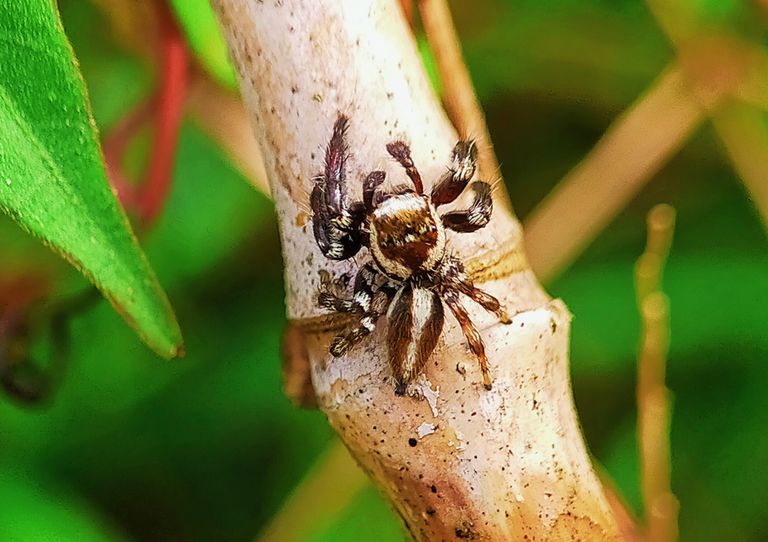
And there is another unique thing, that is, when entering the breeding season, these jumping spiders do a 'dance', in which colored or colorful body parts are displayed. As well as displays of hair, the jumping spider performs complex sideling, vibrational, or zigzag movements to attract the attention of the female. These species vary greatly in the visual and vibrational components of mating. Many species have UV reflection patches, which are exhibited on adult males. This visual ability is used by some female jumping spiders for mate choice. Dimorphism in body size appears to play a role in male competition, in which males with larger bodies will be stronger to bend competitors so they cannot fight back. Because larger spiders have a better chance of winning the fight, they also have a greater chance of successfully mating and will be favored by sexual selection.

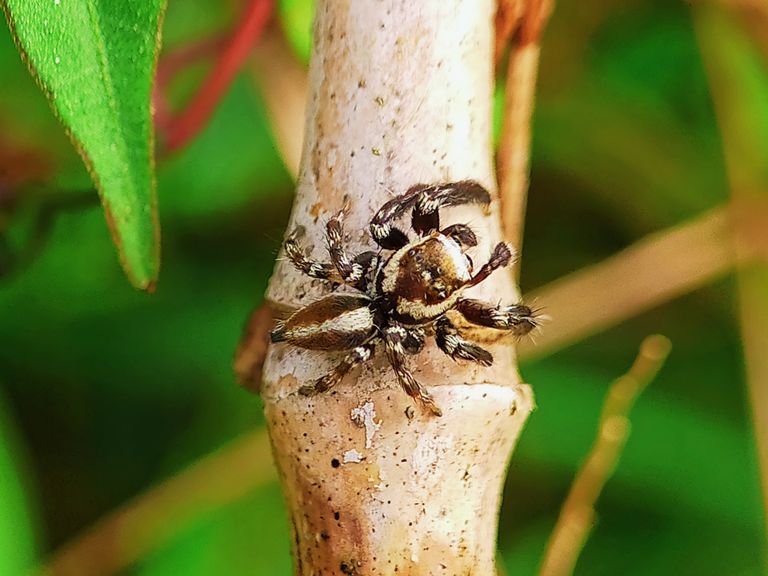
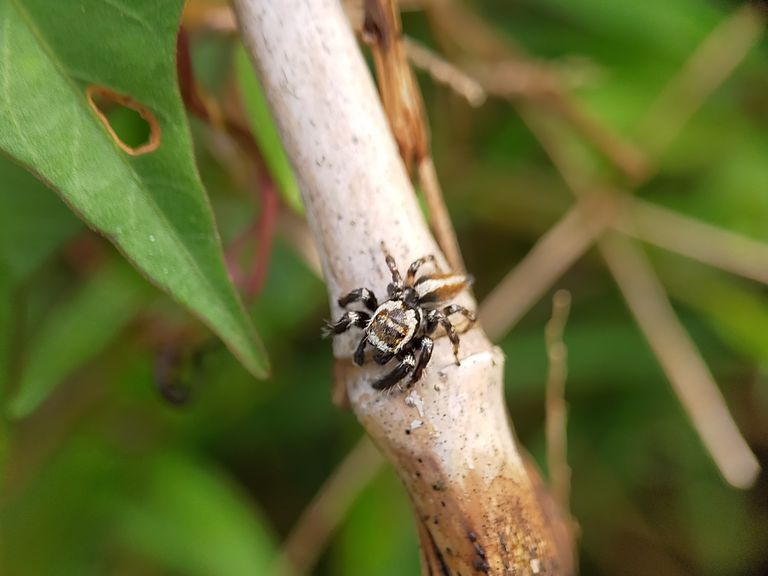
This is all I can say more and less I apologize, hopefully it will be useful for me, and hopefully it will be useful for all readers in general, thank you for visiting my blog, don't forget to follow and vote for my posts. , and one more thing, don't forget to share this post with other friends.
Thank you for visiting my blog, don't forget to follow and vote for me to post, and others don't forget to share this post with other friends.
Greetings to all on Blurtter...
** Your post has been upvoted (3.77 %) **
Curation Trail is Open!
Join Trail Here
Delegate more BP for bigger Upvote + Daily BLURT 😉
Delegate BP Here
Upvote
https://blurtblock.herokuapp.com/blurt/upvote
Thank you 🙂 @tomoyan
Congratulations, your post has been curated by @r2cornell, a curating account for @R2cornell's Discord Community.